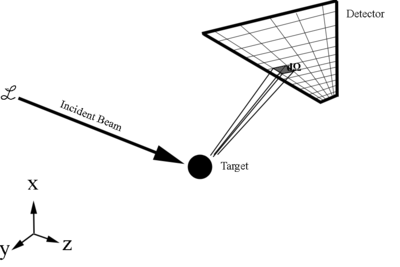Difference between revisions of "Scattering Cross Section"
| Line 37: | Line 37: | ||
| − | <center><math>\frac{\partial^2\sigma_{Lab}}{\ | + | <center><math>\frac{\partial ^2\sigma_{Lab}}{\partial p_{Lab}\,\partial \Omega_{Lab}}\partial p_{Lab}\,\sin{\theta_{Lab}}\,d\theta_{Lab}\,d\phi_{Lab}=\frac{d^2\sigma_{CM}}{dp_{CM}\, d\Omega_{CM}}dp_{CM}\, \sin{\theta_{CM}}\,d\theta_{CM}\,d\phi_{CM}</math></center> |
| Line 50: | Line 50: | ||
| − | <center><math>\frac{\partial^2\sigma_{Lab}}{\ | + | <center><math>\frac{\partial ^2\sigma_{Lab}}{\partial p_{Lab}\,\partial \Omega_{Lab}} dp_{Lab}\,\sin{\theta_{Lab}}\,d\theta_{Lab}=\frac{\partial ^2\sigma_{CM}}{\partial p_{CM}\, \partial \Omega_{CM}}dp_{CM}\, \sin{\theta_{CM}}\,d\theta_{CM}</math></center> |
| Line 60: | Line 60: | ||
| − | <center><math>\frac{\partial^2\sigma_{Lab}}{\ | + | <center><math>\frac{\partial ^2\sigma_{Lab}}{\partial p_{Lab}\,\partial \Omega_{Lab}} dp_{Lab}\,d(\cos{\theta_{Lab}})=\frac{\partial ^2\sigma_{CM}}{\partial p_{CM}\, \partial \Omega_{CM}}dp_{CM}\, d(\cos{\theta_{CM}})</math></center> |
| − | <center><math>\frac{\partial^2\sigma_{Lab}}{\ | + | <center><math>\frac{\partial ^2\sigma_{Lab}}{\partial p_{Lab}\,\partial \Omega_{Lab}} =\frac{\partial ^2\sigma_{CM}}{\partial p_{CM}\, \partial \Omega_{CM}} \frac{dp_{CM}\,d(\cos{\theta_{CM}})}{dp_{Lab}\,d(\cos{\theta_{Lab}})}</math></center> |
| − | <center><math>\frac{\partial^2\sigma_{Lab}}{\ | + | <center><math>\frac{\partial ^2\sigma_{Lab}}{\partial p_{Lab}\,\partial \Omega_{Lab}} =\frac{\partial ^2\sigma_{CM}}{\partial p_{CM}\, \partial \Omega_{CM}} \frac{\partial (p_{CM}\,\cos{\theta_{CM})}}{\partial (p_{Lab}\,\cos{\theta_{Lab}})}</math></center> |
| Line 75: | Line 75: | ||
We can use the chain rule to find the transformation term on the right hand side: | We can use the chain rule to find the transformation term on the right hand side: | ||
| − | <center><math>\frac{\partial(p^*\,\cos{\theta^*)}}{\partial(p^*\theta^*\phi^*)} \frac{\partial(p^*\theta^*\phi^*)}{\partial(p^*_xp^*_yp^*_z)} \frac{\partial(p^*_xp^*_yp^*_z)}{\partial(p_xp_yp_z)} \frac{\partial(p_xp_yp_z)}{\partial(p\theta\phi)} \frac{\partial(p\theta\phi)}{\partial(p\,\cos{\theta})}=\frac{\partial(p^*\cos{\theta^*})}{\partial(p\cos{\theta})}</math></center> | + | <center><math>\frac{\partial (p^*\,\cos{\theta^*)}}{\partial (p^*\theta^*\phi^*)} \frac{\partial (p^*\theta^*\phi^*)}{\partial (p^*_xp^*_yp^*_z)} \frac{\partial (p^*_xp^*_yp^*_z)}{\partial (p_xp_yp_z)} \frac{\partial (p_xp_yp_z)}{\partial (p\theta\phi)} \frac{\partial (p\theta\phi)}{\partial (p\,\cos{\theta})}=\frac{\partial (p^*\cos{\theta^*})}{\partial (p\cos{\theta})}</math></center> |
| − | <center><math>\frac{\partial(p^*\cos{\theta^*})} {\partial(p^*\theta^*\phi^*)}=\frac{\ | + | <center><math>\frac{\partial (p^*\cos{\theta^*})} {\partial (p^*\theta^*\phi^*)}=\frac{\partial p^* \sin{\theta^*} \partial \theta^* \partial \phi^*}{\partial p^*\partial \theta^*\partial \phi^*}=\sin{\theta^*}</math></center> |
| Line 85: | Line 85: | ||
| − | <center><math>\frac{\partial(p\theta\phi)}{\partial(p\,\cos{\theta})}=\frac{1}{\sin{\theta}}</math></center> | + | <center><math>\frac{\partial (p\theta\phi)}{\partial (p\,\cos{\theta})}=\frac{1}{\sin{\theta}}</math></center> |
| Line 111: | Line 111: | ||
This allows us to express the term: | This allows us to express the term: | ||
| − | <center><math>\frac{\partial(p^*\theta^*\phi^*)}{\partial(p^*_xp^*_yp^*_z)}=\biggl[\frac{\partial(p^*_xp^*_yp^*_z)}{\partial(p^*\theta^*\phi^*)}\biggr]^{-1}=\biggl[\frac{\partial(p^*\sin{\theta^*}\cos{\phi^*}p^*\sin{\theta^*}\sin{\phi^*}p^*\cos{\theta^*})}{\ | + | <center><math>\frac{\partial (p^*\theta^*\phi^*)}{\partial (p^*_xp^*_yp^*_z)}=\biggl[\frac{\partial (p^*_xp^*_yp^*_z)}{\partial (p^*\theta^*\phi^*)}\biggr]^{-1}=\biggl[\frac{\partial (p^*\sin{\theta^*}\cos{\phi^*}p^*\sin{\theta^*}\sin{\phi^*}p^*\cos{\theta^*})}{\partial p^*\partial \theta^*\partial \phi^*}\biggr]^{-1}</math></center> |
| − | <center><math>\frac{\partial(p^*\theta^*\phi^*)}{\partial(p^*_xp^*_yp^*_z)}=\biggl[ \frac{\ | + | <center><math>\frac{\partial (p^*\theta^*\phi^*)}{\partial (p^*_xp^*_yp^*_z)}=\biggl[ \frac{\partial p^{*-1}\cos{\theta^{*}}^{-1}} {\partial p\,d\theta^*}\biggr]=\frac{1}{p^{*2}\sin{\theta^*}}</math></center> |
| Line 120: | Line 120: | ||
| − | <center><math>\frac{\partial(p_xp_yp_z)}{\partial(p\theta\phi)}=p^2\sin{\theta}</math></center> | + | <center><math>\frac{\partial (p_xp_yp_z)}{\partial (p\theta\phi)}=p^2\sin{\theta}</math></center> |
| Line 137: | Line 137: | ||
| − | <center><math>\frac{\partial(p^*_xp^*_yp^*_z)}{\partial(p_xp_yp_z)}=\frac{\ | + | <center><math>\frac{\partial (p^*_xp^*_yp^*_z)}{\partial (p_xp_yp_z)}=\frac{\partial p^*_z}{\partial p_z}=\frac{\partial (-\beta^* \gamma^*E+\gamma^* p_z)}{\partial p_z}=-\beta^* \gamma^*\frac{\partial E}{\partialp_z}+\gamma^*</math></center> |
Revision as of 14:36, 3 February 2016
Scattering Cross Section

Since this is just a ratio of detected particles to total particles, this gives the cross section as a relative probablity of a scattering, or reaction, to occur.
Transforming Cross Section Between Frames
Transforming the cross section between two different frames of reference has the condition that the quantity must be equal in both frames. This is due to the fact that
This makes the total cross section a Lorentz invariant in that it is not effected by any relativistic transformations
This implies that the number of particles going into the solid-angle element d ΩLab and having a momentum between pLab and pLab+dpLabbe the same as the number going into the corresponding solid-angle element dΩCM and having a corresponding momentum between pCM and pCM+dpCM
As shown earlier,
We can use the fact that
We can use the chain rule to find the transformation term on the right hand side:
Similarly,
Using the conversion of cartesian to spherical coordinates we know:
and the fact that as was shown earlier, that
This allows us to express the term:
Again, similarly
To find the middle component in the chain rule expansion,
which gives,